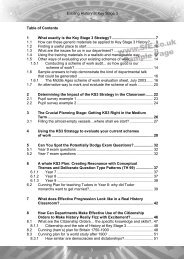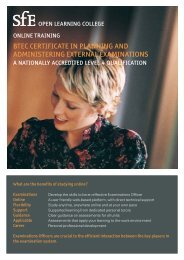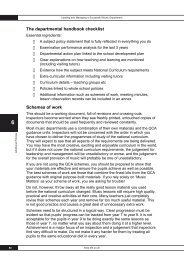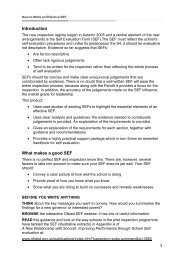Experiential RE supdocs.indd - SfE
Experiential RE supdocs.indd - SfE
Experiential RE supdocs.indd - SfE
You also want an ePaper? Increase the reach of your titles
YUMPU automatically turns print PDFs into web optimized ePapers that Google loves.
y sophisticated information technology – except in school.<br />
No wonder they switch off when we come up with our information packages delivered in an<br />
archaic fashion which was interesting and exciting, in the past – to us.<br />
Those two experiences of learning about war underline my belief that it is not the information<br />
that fails to engage but the method. That is why we find ourselves angry and frustrated when<br />
young people do not seem to respond to issues that we feel are important. We need to find a way<br />
in through imagination and emotion, to “light the fire in their bellies,” as Anita Haigh, Advisory<br />
teacher for Citizenship and PSHE in West Sussex, puts it.<br />
Creating engagement, atmosphere and pace with lighting in the Theatre of Learning<br />
We work in soft lighting, provided by lamps and spotlights, which creates an atmosphere in the<br />
classroom, every lesson, which is more powerful than the pupils’ own agenda. Entering the circle<br />
to music which is gently faded, along with the lights, timed to their gradually ceasing chatter<br />
means I no longer start lessons frazzled and cross, or shouting – and neither do they – it is like<br />
the lights going down in the cinema. Everyone waits to see what is going to happen.<br />
The pupils may enter a brightly lit room to lively music for the introduction to the lesson which<br />
may be fast paced and energising, for example a true/false exercise testing previous knowledge.<br />
Then there may be a change of pace and atmosphere to set the scene for an emotional story, soft<br />
music fills the room, soothing the pupils and enabling them to change gear emotionally. The lights<br />
will be faded so that the room is lit by spotlights or table lamps, or perhaps simply the overhead<br />
projector shining on to the board to pick out the keywords that will appear in the story. There<br />
will be gentle fairy lights woven throughout the centre display so that the pupils have something<br />
attractive to look at and focus on. The music and the lighting, together, invite the children into<br />
the story, shutting out the outside world, their own thoughts and distractions from each other.<br />
The atmosphere allows them to focus, to concentrate, to feel, to think and to imagine. In this<br />
atmosphere the potential for learning is maximised as the subject information is delivered. It may<br />
be through a visualisation, a mind movie (see p12), or a short story, all of which I have written<br />
myself, both as a vehicle for the subject content and to provoke an emotional response.<br />
Often I find, when supporting other teachers as a mentor, following observations or having been<br />
called to a classroom to settle a disruptive class, I am faced with a frustrated, often angry teacher<br />
who says “They just won’t listen! They won’t give me a chance.”<br />
We need to put ourselves into the shoes of the pupils entering a normal classroom, not<br />
necessarily through choice, to listen to information that they do not necessarily wish to know, in<br />
an environment that might not be very attractive and which is full of distractions (ie each other),<br />
and ask ourselves: “is this how people in advertising would work? What are you going to sell in<br />
circumstances like these? And if you have to work in these circumstances (which we do!) then<br />
what is the best way to grab the attention of your customers?”<br />
We need to ask ourselves: “what can we do to change the way we deliver the core content of our<br />
lessons?”<br />
We have looked so far at creating a multi-sensory environment. We have begun to look at the role<br />
of emotion and imagination in engaging the whole child. Now we need to think about the methods<br />
we might use within our engaging, multi-sensory environment. Here are two techniques, which<br />
have had the most profound effect on the pupils’ spirituality and moral development. What I call<br />
religion neutral exercises and participatory symbols.<br />
<strong>Experiential</strong> <strong>RE</strong>: Supporting documents<br />
9








